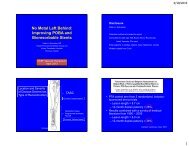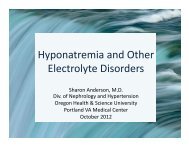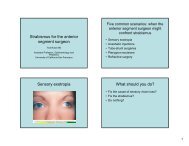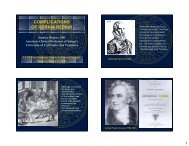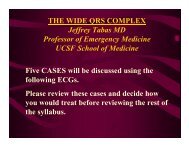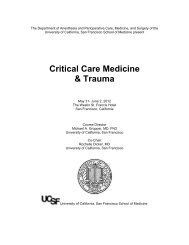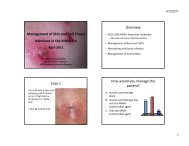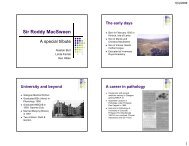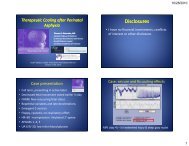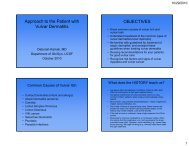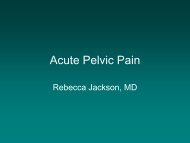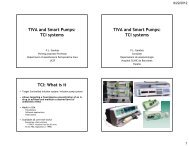Clinical Problem Solving Exercise
Clinical Problem Solving Exercise
Clinical Problem Solving Exercise
- TAGS
- clinical
- solving
- ucsfcme.com
You also want an ePaper? Increase the reach of your titles
YUMPU automatically turns print PDFs into web optimized ePapers that Google loves.
<strong>Clinical</strong> <strong>Problem</strong>-<br />
<strong>Solving</strong> (CPS) Cases<br />
Gurpreet Dhaliwal, MD<br />
Management of the Hospitalized Patient<br />
2012
“They are presented every conceivable problem<br />
related to their specialty. They solve cases by history<br />
alone. They laugh a lot and clearly enjoy what they<br />
are doing. And not only do they demonstrate superb<br />
diagnostic acumen, but they also model many of the<br />
ACGME Core Competencies.”
Ground Rules for CPS <strong>Exercise</strong><br />
• Goop has never heard these cases<br />
– Not a trivial undertaking<br />
• Today: 2 cases, one bread & butter, other<br />
a little harder<br />
• Goal is to make the thought process of a<br />
master clinician transparent<br />
–It’s not magic<br />
– You don’t have to “know everything”<br />
• “Getting it right” is cool, but relatively<br />
unimportant in the grand scheme<br />
• Enjoy – this is the fun part of medicine
Case #1: <strong>Clinical</strong> History<br />
CC: An 82 year-old woman with thoracic spine<br />
compression fractures presented to the ED with<br />
post-traumatic back pain.<br />
HPI: The patient has a history of osteoporosis<br />
and prior t-spine compression fractures, treated<br />
with kyphoplasty in the past. She developed<br />
severe back pain after being accidentally struck<br />
in the back during happy hour at her<br />
independent living facility. Unable to achieve<br />
relief with Tyco, she presented to the ED a<br />
week later. She noted constipation but no<br />
radiation, focal neurologic sxs, or incontinence.
Scene from Happy Hour
Past History/Meds/Social History<br />
• Osteoporosis with kyphoscoiosis<br />
– On no meds, couldn’t tolerate alendronate<br />
• S/p kyphoplasty x2 (most recent 2011): good relief<br />
• “Irregular heart beat” – exact etiology unclear<br />
• HTN<br />
• Hyperlipidemia<br />
• Symptomatic GERD<br />
• Meds: Metoprolol, pravistatin, omeprazole, Tylenol<br />
#4, occasional vitamin D/calcium<br />
• SH: nonsmoker, occ EtoH, no drug abuse; lives in<br />
independent living facility
Physical Exam<br />
• T 36.6, HR 76, BP 122/85, RR 18, 99% RA, pain<br />
8/10<br />
• General: Mild distress from back pain<br />
• HENNT: NC/AT, EOMI, PERRL, OP clear, neck<br />
supple<br />
• CV: RRR, no m/r/g, no jvd<br />
• Resp: Lungs clear bilaterally<br />
• GI: +BS, soft NT, slightly distended, no masses<br />
• MSK: Severe kyphosis, TTP mid T-spine<br />
• Neuro: A&O x 3, CNs 2-12 intact. 4+/5 strength, nl<br />
sensation, 2+ reflexes throughout
Goop’s Initial Thoughts
\ 12.4 /<br />
6.7 ---- 331<br />
/ 36.8 \<br />
Labs<br />
139| 103 | 11 /<br />
---------------------- 114<br />
3.6 | 27 | 0.61 \<br />
INR: 1.0<br />
Trop:
Admission Chest X-Ray
Admission EKG
CT of Spine
Initial Plan<br />
• Admitted to medicine w/ neurosurg consult<br />
• Consultants recommended spinal fusion<br />
with kyphoplasty under general anesthesia<br />
if pain persists<br />
• Plan: pain control, bowel regimen, PT/OT,<br />
admit to tele, MI ruled out, cont home meds<br />
• Pain control difficult; day 4 patient went to<br />
OR for posterior spinal fusion with<br />
kyphoplasty of acutely compressed<br />
vertebrae
Immediate Post-Op Course<br />
• Lengthy but uneventful OR case, minimal<br />
blood loss<br />
• Within a few minutes of wound closure,<br />
she developed acute hypotension (SBP<br />
60s), HR fell to 40s. Unresponsive to fluids<br />
and phenylephrine<br />
• Sedation held, patient turned supine, given<br />
atropine and started on epi drip
Post-Op Studies<br />
ABG: 7.26/28/216 (100% FiO2), lactate 7.5, Hgb 6.7<br />
4 units PRBC transfused: Hgb 6.7 -> 9.6 -> 13.1<br />
\ 14.7 /<br />
13.9 ---- 113<br />
/ 43.5 \<br />
139| 111 | 7 / iCa: 1.02 INR: 1.6<br />
---------------------- 169 Mg: 1.9 PTT: 40.2<br />
4.5 | 21 | 0.61 \ Phos: 7.2 Trop: 0.15
Post-Op CXR
Post-Op EKG
Admission EKG (for comparison)
Vital signs at ICU admission<br />
• T 37.6, HR 90s, BP 117/80, RR 20, 99% on AC<br />
400 x 10, PEEP 5, FiO2 100%<br />
• Intubated, sedated, not arousable but pupils<br />
equal, + gag, + cough<br />
• CVR: Irregularly irregular, nl s1s2, no m/r/g<br />
appreciated. Distended neck veins present.<br />
• Pulmonary: Lungs clear bilaterally<br />
• MSK: Extremities cool distally<br />
• Exam otherwise unchanged except for surgical<br />
changes
What do you think is going on?<br />
1. Cardiac tamponade<br />
2. Tension pneumothorax<br />
3. Pulmonary embolism<br />
4. RV infarct<br />
5. Septic shock<br />
6. TRALI<br />
7. Thyrotoxic storm
TTE
TTE
What would you do now?<br />
1. Unfractionated heparin<br />
2. One of those new-fangled anticoagulants<br />
3. Stress dose steroids<br />
4. Broad-spectrum antibiotics<br />
5. Aspirin<br />
6. Emergent cardiac catheterization<br />
7. CT angiogram of chest
ICU Management and Course<br />
• Team felt PE vs. RV infarct most likely dx<br />
• Troponins trended, peaked at 1.7<br />
• Anticoagulation considered but held in<br />
light of recent spine surgery<br />
• After transfusions, hemoglobins trended<br />
and remained stable
A diagnostic procedure<br />
was performed
Gurpreet Dhaliwal,<br />
Gurpreet Dhaliwal,<br />
what is your…<br />
final answer?
Final Diagnosis<br />
• Cement pulmonary embolism<br />
– Extending from main pulmonary artery trunk<br />
to RUL PAs; other fragments in paravertebral<br />
and azygos vein
Management and Course<br />
• After discussion with IR, pulm and cards, decision<br />
made not to try to remove cement<br />
• Anticoagulation discussed (cement is often<br />
thrombogenic) but withheld due to recent surgery<br />
• Right heart failure managed with dobutamine,<br />
levophed, diuretics, amiodarone, inhaled NO<br />
• Improved and extubated day 5, weaned off<br />
pressors<br />
• Complex hospital course (UTI, ileus, delirium) but<br />
improved. Repeat TTE: RV smaller, better EF<br />
• Discharged to SNF – no SOB, back pain
Now at the Independent Living<br />
Center…
Take Home Points<br />
• Kyphoplasty: used for<br />
pain control of<br />
osteoporotic<br />
compression fxs<br />
– Surgeon enters weak part<br />
of bone, dilates space<br />
with balloon, injects<br />
methymethacrylate<br />
cement, which hardens<br />
– Usually closed or<br />
minimally invasive surgery
Take Home Points<br />
• About 20% of patients have some cement<br />
leakage outside spine<br />
– Usually asymptomatic or nerve root<br />
compression<br />
• ~ 300 cases in literature of symptomatic PE;<br />
probably about 1-3% incidence (asx higher)<br />
– No consensus on management<br />
• ? Heparin – probably yes ? Surgical removal – if dire<br />
• Treat right heart failure if present<br />
• Prevention: use “toothpaste” consistency<br />
cement, slow injection, stop if extravasation<br />
Krueger. Management of pulmonary cement embolism…: a systematic review of<br />
the literature. Eur Spine J 2009.
CASE #2
HPI<br />
� 37 year-old man with no significant PMH<br />
presents with 4 days of chills, sweats,<br />
diarrhea, N/V, generalized weakness, and<br />
severe fatigue.<br />
� On presentation to the ER, he was febrile<br />
to 39 with a HR of 148, BP 136/84, RR 30,<br />
and O2 sat of 98% on NRB. His CXR<br />
showed a multi-lobar infiltrate and he was<br />
intubated for respiratory distress.
Goop’s Initial Thoughts
6 wks PTA<br />
Oral surgery c/b infection<br />
Takes ABx, resolves<br />
5 wks PTA<br />
Visits ex-fiancee in Rhode Isl.<br />
Feeling well<br />
No significant exposures<br />
More HPI…<br />
3 wks PTA<br />
Goes to Sonoma with friends for a week<br />
Returns to SF feeling well<br />
1 wk PTA<br />
Goes to Pittsburgh for a funeral<br />
Starts feeling ill: diaphoretic, chills, fatigue<br />
Skips the funeral, returns to SF<br />
Develops diarrhea, epistaxis, confusion<br />
Brought to the ER
A bit more about Sonoma…<br />
• A group of friends stayed at a house in Sonoma<br />
• Copious quantities of food and wine consumed<br />
• Spent lots of time in a hot tub<br />
• One of the other guests had flown in from India<br />
and had flu-like symptoms and “a stiff neck”<br />
• Many of the other guests developed flu-like sx<br />
while they were there (our patient did not)<br />
• The house in Sonoma said to have once had a<br />
“rodent problem,” but this was thought to be<br />
under control
More History<br />
•PMH: none<br />
• Meds: none<br />
• SH/Exposures:<br />
– Lives in the Mission District of SF, works<br />
downtown as a computer analyst<br />
– No tobacco, occasional EtOH<br />
– H/o remote Ecstasy use, none currently and<br />
no h/o IVDU<br />
– No pets<br />
– Sexual history unclear<br />
•FH:none
The most salient clue here is…<br />
1. Hot tub<br />
2. Rodents<br />
3. Wine<br />
4. Pittsburgh<br />
5. Ecstasy use<br />
6. Computer analyst<br />
7. Flu in friends<br />
8. Diarrhea
Physical Exam<br />
• VS: Temp 39.0, BP 136/84, HR 148, RR<br />
30, O2 98% on 100% NRB � intubated<br />
• General: Sedated<br />
• HEENT: PERRL, OP clear<br />
• Lungs: Bilateral rhonchi<br />
• CV: Tachy, no MRG<br />
• Abd: Soft, NT<br />
• Extremities: No edema<br />
• Meuro: Alert and oriented x 4, non-focal.<br />
Neck supple
15<br />
42<br />
126<br />
Diff: 98% PMNs<br />
133<br />
2.7<br />
97<br />
19<br />
Data<br />
54<br />
142<br />
3.6<br />
1.1<br />
385 76<br />
55<br />
coags nl<br />
lipase 85<br />
CK 16,000
CXR
Chest CT
I think this is most likely to be…<br />
1. Wegener’s granulomatosis<br />
(or whatever they’re calling it these days)<br />
2. Influenza pneumonia<br />
3. Coccidiomycosis<br />
4. Pneumocystis pneumonia<br />
5. Tularemia<br />
6. Tuberculosis<br />
7. Legionella pneumonia<br />
8. Endocarditis<br />
9. Hantavirus
Microbiology<br />
• HIV Ab and VL: negative<br />
• Blood Cultures x 4: negative<br />
• Influenza A and B: negative<br />
• Trach aspirate x 2: oral flora<br />
• Sputum AFB x 3: negative
Hospital Course<br />
• The patient was started on ceftriaxone and<br />
azithromycin<br />
• He remained febrile and his WBC<br />
remained at 15<br />
• CVVH begun for rhabdo/ARF<br />
• On HD#3, ABx were changed to<br />
vanc/cefepime/azithro<br />
• ID was consulted on HD#6 given lack of<br />
improvement
A diagnostic procedure was<br />
performed
Gurpreet Dhaliwal,<br />
Gurpreet Dhaliwal,<br />
what is your…<br />
final answer?
Legionella testing returns<br />
• Legionella urine antigen positive<br />
• Legionella culture was negative (sent 7<br />
days into therapy)<br />
• Legionella Ab (against L pneumophila<br />
serogroup 1):<br />
– IgM 1:64 (normal is
Case Follow-up<br />
• He was treated with azithromycin 500mg<br />
IV daily for 2 weeks<br />
• He was extubated after 2 weeks and<br />
was weaned off hemodialysis<br />
• He was discharged ~3 weeks after<br />
admission in good condition
Legionella: History<br />
• American Legion convention,<br />
July 1976 at the Bellevue-<br />
Stratford Hotel in Philadelphia<br />
• 221 cases, 34 were fatal<br />
• An EIS led investigation<br />
eventually identified Legionella<br />
pneumophila<br />
• Use of an antibody test led to<br />
the discovery that several prior<br />
unsolved PNA outbreaks (as<br />
far back as 1947) had been<br />
due to Legionella Bellevue-Stratford Hotel, Philadephia<br />
(closed 1976-79 but then re-opened)<br />
Fraser, 2005. The challenges were legion. Lancet ID 2005.
College Students Self-Medicating
Microbiology/Ecology<br />
• Natural habitats:<br />
– Aquatic environments (streams, ponds, thermal pools)<br />
– Moist soil, mud, potting soil<br />
– Optimal growth temperature of 35°C<br />
• All outbreaks associated w/ man-made aquatic<br />
habitats:<br />
– Human-made water sources with warm water:<br />
• Air-conditioning towers, hot water systems, shower heads,<br />
whirlpool spas, respiratory ventilators, fountains, ice machines<br />
• Construction can lead to alterations in plumbing<br />
– Often form biofilms in water systems, and thus can<br />
survive chlorination or biocides<br />
• Transmission: inhalation by aerosol<br />
Diederen. Legionella spp and Legionairres’ Disease. J Infection 2008.<br />
Fields et al. Legionella and Legionnaires’ Disease. Clin Micro Rev 2002.
Host Risk Factors<br />
• Increased age (peak in the 60s-70s)<br />
• Males>females<br />
• Impaired respiratory or cardiac function<br />
• Alcoholism<br />
• Tobacco use<br />
• Immunocompromise (cancer, AIDS, ESRD)<br />
• Diabetes mellitus<br />
• Travel (hotel, campsites, cruise ship) in<br />
25%
• Legionella<br />
accounts for 2-<br />
15% of CAP in<br />
various studies<br />
• Considered one<br />
of the main<br />
causes severe<br />
CAP<br />
Legionella and CAP<br />
Falco et al. Legionella pneumophila: A cause of severe CAP. Chest 1991.
Legionella: <strong>Clinical</strong> Findings<br />
• Incubation 2-10 days<br />
• <strong>Clinical</strong> features:<br />
– Fever, myalgias, headache, anorexia common (may be<br />
prodrome)<br />
– Non-productive cough, dyspnea<br />
– Diarrhea<br />
– Neuro symptoms: especially AMS<br />
• Labs:<br />
– Elevated CK, hyponatremia, abnormal LFTs<br />
– Pancreatitis (rare)<br />
• Mortality rate<br />
– 10% (down from 26% in 1970s)<br />
Diederen. Legionella spp and Legionairres’ Disease. J Infection 2008.
Legionella vs Strep Pneumo<br />
• Less likely pleuritic,<br />
purulent; more likely<br />
GI, neuro sxs<br />
• No difference in initial<br />
CXR<br />
– But Legionella often<br />
progressed to<br />
multilobar<br />
involvement<br />
• Labs:<br />
– No difference in<br />
hyponatremia<br />
– Legionella more likely<br />
to have elevated<br />
AST/ALT, alk phos,<br />
creatinine<br />
Falco et al. Legionella pneumophila: A cause of severe CAP. Chest 1991.
Infectious Causes of Rhabdo<br />
Viral Infections<br />
• Due to direct viral<br />
invasion of muscle<br />
• 34% had ARF, 8% died<br />
• Etiology (# cases):<br />
– Influenza A and B (25)<br />
– HIV (8)<br />
– Coxsackie (8)<br />
– EBV (5)<br />
– Echovirus (4)<br />
– CMV, adenovirus (2)<br />
– HSV, parainfluenza, VZV<br />
(1)<br />
Bacterial Infections<br />
• Due to toxin generation and<br />
direct muscle invasion<br />
• 57% had ARF, 38% died<br />
• Etiology (# cases)<br />
– Legionella (14)<br />
– Francisella tularensis (9)<br />
– Strep pneumo (8)<br />
– Salmonella (6)<br />
– Staph aureus (5)<br />
– GAS, GBS, Listeria, Vibrio (2)<br />
Singh and Scheld. Infectious causes of rhabdomyolysis. CID 1996.
Take Home Points<br />
• Clues to diagnosis of Legionella pneumonia:<br />
– Water exposure (hot tub, spa, plumbing work)<br />
– Recent travel (within 2 weeks)<br />
– Elevated CK, transaminases<br />
– Negative cultures<br />
– Severe PNA requiring ICU care<br />
• Diagnosis best made by combination of urine Ag (best<br />
sensitivity and specificity) with sputum culture (for<br />
detection of other subtypes, serogroups, species)<br />
• Treat with levofloxacin or azithromycin
• Seth Cohen<br />
• Kara Bischoff<br />
• Jenn Babik<br />
Thank You
Helen Keller on Exposures<br />
“Avoiding danger is no<br />
safer in the long run than<br />
outright exposure. The<br />
fearful are caught as often<br />
as the bold.”




